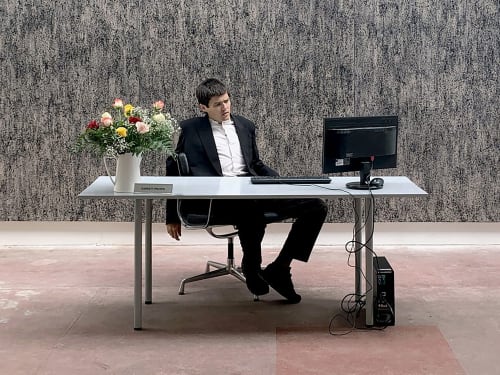EG: I am also interested in hearing more about how the human form and figuration has become more central in the work?
GP: Yeah, I mean that is the significant challenge because of the way the film is shot, and a lot of the crucial scenes have birds in the background which makes it easier to deal with but when the birds come into the foreground, it is a whole different thing because there are some frames where it is completely "bird", and you can't see anything else. So, this issue of having to fill in the gaps between the movement, requires rendering of the face and the form, to make it look somewhat believable. It's never pursued perfection, it's very much the hand present in the frames which makes the erasure very visible, and it becomes kind of a remnant or a specter of something happening.
EG: You showed the first instalment of the film ('The Birds (1)' red.) at Trafalgar Avenue in London last May. In this show at Brigade, you are also exploring montage prints and rows of sequential stills, and I wondered if you expand upon the relationship to the original material in the still works?
GP: It's funny because this really is a film project, but at the same time I think because of how much labor goes into each frame, and because it's like a frame-by-frame process, I have come to really see it as a collection of frames and stills. I spend a lot of time looking at each of them individually, and so it makes sense to slow down as much as possible to see it in its original cinematic format, but also as a collection of digital paintings - especially as you see it in the row with the boy running, it kind of presents the technical aspects that I found when working with it, and there are a lot of moments when the thing being captured isn't fully captured by the camera; there are these motion blurs and other technical defects happening and so in erasing the birds from these scenes and having to recreate or replicate these motion blurs, lens flairs and light leaks, the kind of flaws or "the hand" of the original film.
EG: That reminds me of the two juxtaposed stills featuring the hands. In works like these, we also get to peek into the process behind the video work; how you are drawn to different imagery within Hitchcock's film, uncovering unseen and unknown moments within the original, presented through your gaze.
It has also been very interesting to learn how sound functions within this project, perhaps you could expand on how the sound design has become more central as you progress?
GP: Yes, part of the project is also getting rid of the bird sounds, and as the film goes on the sounds of the birds become overwhelming in the audio. In earlier scenes I can kind of filter the sounds out, and then in some of the scenes there are so many bird sounds that you can't hear anything else really. I realized that the only way to have audio is to completely recreate it, and so I made all these fully done recordings and built the audio from the scenes completely from scratch - everything from footsteps to the sound of fabrics, to the more obvious things like explosions and glass shattering etc. I also had one of my friends do the breathing and kind of the voice of Melanie Daniels - I know that no one is ever going to sound just like Tippi Hedren, but it's been a fun exercise to try to reenact the scenes and to make them become as close as possible to what they would have sounded like without those birds.
EG: I think your sound design is just one example of how considered and ambitious this project is. We've also been discussing how many parallels there are with the original film and Hitchcock's approach to everything from set design to sound.
GP: Yeah, Hitchcock was a real obsessive filmmaker, and as we were talking about that one of the interesting facts about the original film is rooted in Hitchcock's decisions to film it in the place of Bodega Bay, even that as the original short story that film is based on, was set in the Cornwall, England. There is nothing inherently required about it being in Bodega Bay, but so much of the film is about Bodega Bay in a strange way. A lot of it is filmed in sound stages, but Hitchcock had this way of making the sets, so they are exact replicas of these particular Bodega Bay buildings. He even sent his costume designer to photograph the townspeople of Bodega Bay to try to get the costumes as close as possible. So, in this very strange way, there is an almost documentarian process put into this, that you would never really know. But there is definitively this sort of obsessive desire to recreate something that he is like lusting over.
EG: And do you feel like this is also a part of the driving force for your work?
GP: It's not the same driving force, but I think that there is this sort of obsession engrained into the work in one way or another.


